Seventeen years to the day since he first suited up in a Major League game, you wouldn’t think Yadier Molina could do much to change his story. As a nine-time Gold Glover who seemingly prevents stolen base attempts merely by reputation, he’s either the greatest defensive catcher of all time or at the very least, in the conversation.
So let's, naturally, talk about his bat.
At 38 years old -- he’ll be 39 on July 13, when he’ll possibly be celebrating by making his 10th All-Star appearance for the National League in Denver -- Molina (.284/.313/.511) has taken on an entirely new hitting profile. He’s hitting the ball harder than ever (a career-best 41% hard-hit rate), in the air more than ever (a career-low 36% ground-ball rate), while striking out more than ever (a career-high 21% strikeout rate). The end result is a 130 OPS+ that's the second-best of his long career. Yadier: Welcome to the revolution.
But it’s more than just that, too, because Molina is also following along with a different trend. He’s swinging at the first pitch -- the ones in the strike zone, anyway -- at nearly a career high, nearly two-thirds of them. (If we're just looking at any first pitch, only three players with at least 100 plate appearances have been more aggressive on the first pitch.) He’s swinging at one of the first two pitches more than he ever has. When he does, he’s doing tremendously more damage then he ever has before, whether it’s first pitch or first two pitches. Sure, he’s got a career-high strikeout rate. But who cares when he’s producing like that?
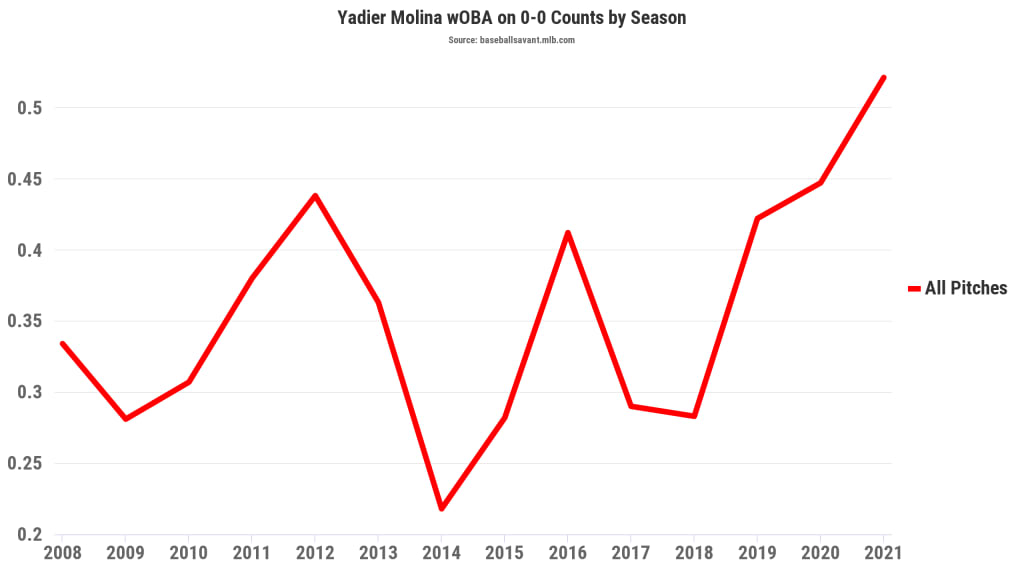
It's not just Molina. Gone, clearly, are the days of working the count, of trying to get into the bullpen, because who wants to do that anymore, knowing most teams have an endless stream of high-velocity arms in reserve? As Nationals veteran Ryan Zimmerman explained it to ESPN:
“I'm not going to take a first-pitch fastball now to get a guy's pitch count up when I will get behind 0-1. That might be the only fastball that I see in that at-bat.”
As you can see, Major League hitters are increasingly likely to go after the first pitch (when it’s in the zone, anyway, because let’s not penalize anyone for accepting the gift of 1-0), and for good reason.
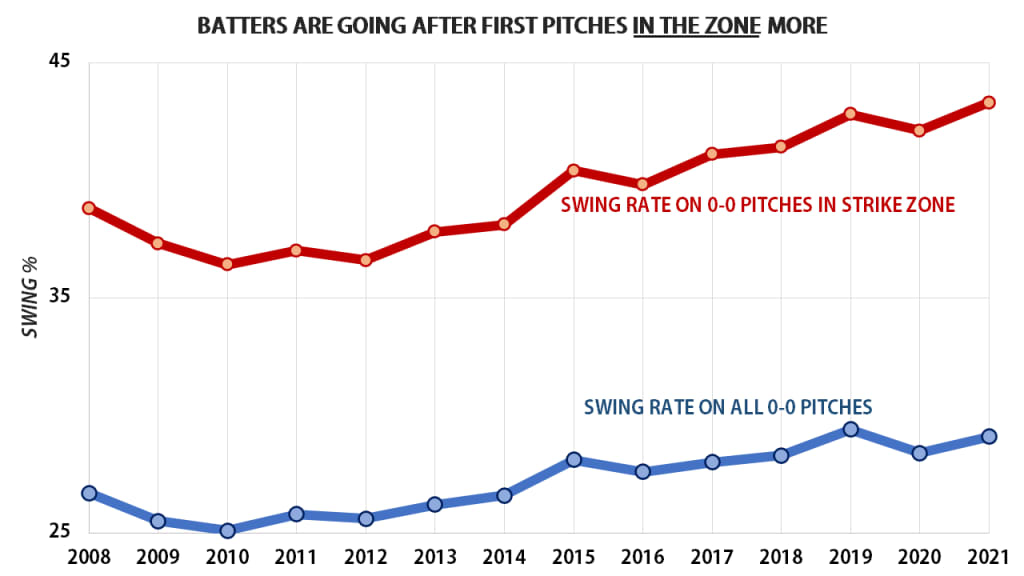
That good reason, of course, is the fear of getting into two-strike counts, which are the baseball version of dying on your feet. That's where the diving sliders and curveballs in the dirt live. It's not where you want to be. While the idea of a "fastball count" is a dying one, there's still the truth that you'll see a breaking or offspeed pitch 38% of the time on the first pitch, 44% of the time on all other counts, and 49% of the time on two strikes.
In 2021, hitters with two strikes are hitting all of .159/.236/.256. It's the lowest two-strike mark on record. If you haven't put the ball in play with zero or one strikes, you might just want to walk back to the dugout.
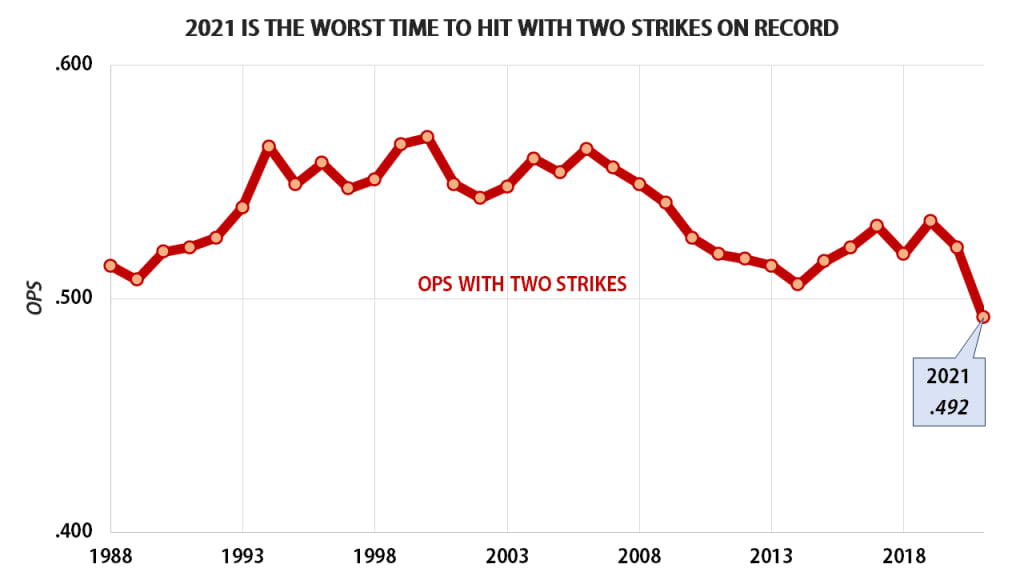
So why let that first-pitch ball in the zone go by? Increasingly, hitters are not. “I’ll still walk if they’re going to walk me,” said notoriously aggressive first-pitch swinger Jeff McNeil last year, “but yeah, if I get a good pitch early in the count, I’m going to try to do some damage.”
This isn’t entirely a new idea; we ourselves wrote about it back in 2014 in terms of how hitters were trying to fend off Clayton Kershaw. Earlier that year, now-Padres executive Dave Cameron wrote that “over the last few years, the first-pitch take has all but lost its advantage over the first-pitch swing.” The year before, Tom Verducci quoted then-Nationals manager Davey Johnson saying that “hitters today think they have to see a lot of pitches, but the best pitch they may see sometimes is the first one. You have to be ready for it.”
That they weren’t is generally accepted to be a relic of the earlier days of the sabermetric movement -- note that the five lowest first-pitch-swing teams on record (dating back to 1988) are all either Billy Beane A’s teams or Theo Epstein Red Sox clubs -- when you’d really want to do things like “get Pedro Martinez out of the game as quickly as you can.”
But around 2015-16, which is really when the game began to tilt towards a blurring of the starter/reliever line ('16 being a particular tipping point, as Terry Francona rode Andrew Miller to the World Series, while Zack Britton is still out there waiting to be called in from the Baltimore bullpen), attitudes slowly began to change. From 2008-16, for example, hitters went after 38% of first-pitch strikes in the zone. Ever since, it’s been 42.1%, with this year’s 43.3% a record high.
You can see why in the production that happens on the first pitch.
On 0-0
.336/.348/.564 -- .912 OPS
After 1-0
.247/.375/.427 -- .803 OPS
After 0-1
.207/.254/.335 -- .588 OPS
Just look at Molina this year: he’s got a .348/.636 average/slugging when he goes after the first pitch, and a .227/.400 when he does not.
Interestingly, one of Molina’s St. Louis teammates has taken a similar approach. Outfielder Dylan Carlson went after a first pitch only 13% of the time last year; this year, he’s more than doubled that to almost 32%, one of the largest jumps in the game. (He has a 1.067 OPS and four of his five home runs in plate appearances where he has gone for a swing on the first pitch.)
Of course, there’s a trick in all those numbers. You can’t strike out on the first pitch! That’s part of why the first-pitch numbers all look good. On the other hand … you can’t strike out on the first pitch. Meanwhile, 52% of 0-0 pitches are in the zone, as compared to 45% on 0-1 (which is where you get if that hittable first pitch goes by) or the 43% with two strikes.
So, really, this all comes down to four questions:
1. Do hitters do better when they swing on the first pitch?
Well, yeah. Like we said: You can’t strike out on the first pitch. That OPS up there? North of .900. That’s been true each year dating back to 2015. It’s actually become increasingly true, really, because before ‘15, it had only happened three times since 1988, when the data begins.
In fact, let’s break it down into somewhat equally sized-chunks, showing OPS on 0-0 counts.
1988-94: .792
1995-2001: .875
2002-08: .891
2009-15: .882
2015-21: .946
2. Is there better contact on the first pitch than after?
Half the idea of going after pitch one is that it might be the best pitch you’re going to get. If so, you might be more likely to make great contact on it. So let’s set aside all those strikeouts and whiffs for a minute, and simply ask: If you make contact, is that 0-0 contact better than the rest? Well, yeah.
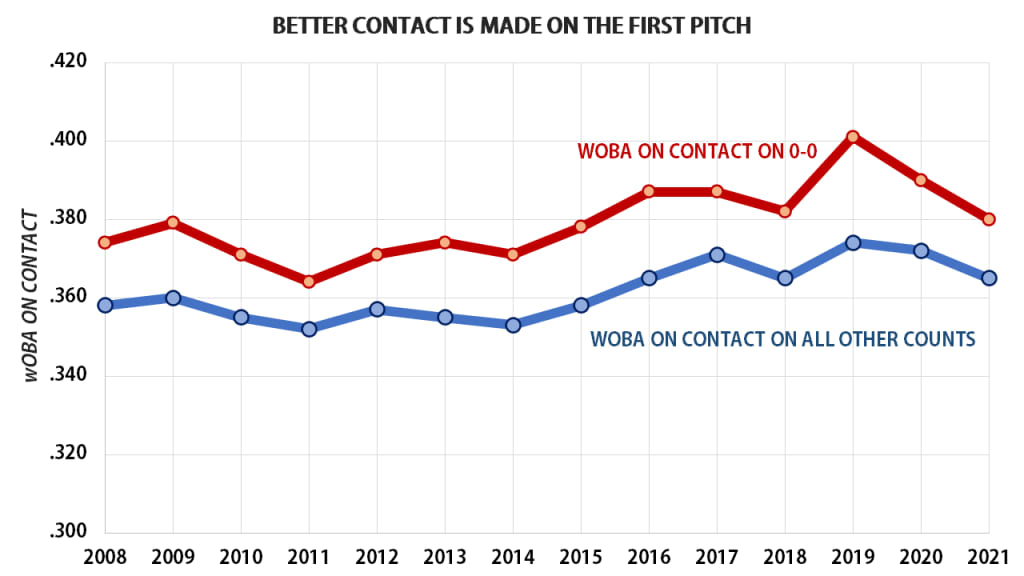
Obviously, that doesn’t mean 0-0 is the best contact count, because 3-0 exists, because 2-0 exists, and so on. But you can’t be sure you ever get there. On the first pitch, your choice is: 0-0 or the mystery box of what comes behind it.
3. Is there more or less contact on the first pitch than after?
So you’ve decided to swing. You might have noticed that it’s a little hard to make contact these days. Does swinging early hurt you?
4. Do hitters do better after the first pitch when they swing on the first pitch?
That’s the game, isn’t it? It’s one thing to be aggressive on the first pitch, knowing you shouldn’t let it go by just for the sake of saying you did, but if you don’t finish your plate appearance right then and there, have you totally screwed up what comes after? This gets complicated, because if you swing and don’t end the plate appearance, you’re down 0-1, but if you don’t swing, you might be down 0-1 anyway.
So, the right thing to do is not to just look on the outcomes of the first pitch, but split the outcomes of all plate appearances based on whether the first pitch was a swing or not. You can see pretty clearly that for many years, from the start of the data in 1988 through around 2000, taking the first pitch was clearly the better strategy. In 1992, for example, there was a 54-point difference in ultimate OPS between taking (.716 OPS) or swinging (.662 OPS). It crept closer for years, until finally in 2015 (and again in '18 and '19), swinging at the first pitch saw better outcomes.
Since 2015, it's a dead heat. Batters have a .737 OPS whether they go after the first pitch or not. That might sound like it doesn't matter, but also saying "it doesn't matter whether you take the first pitch or not" would have, for almost all of baseball history, been blasphemy.
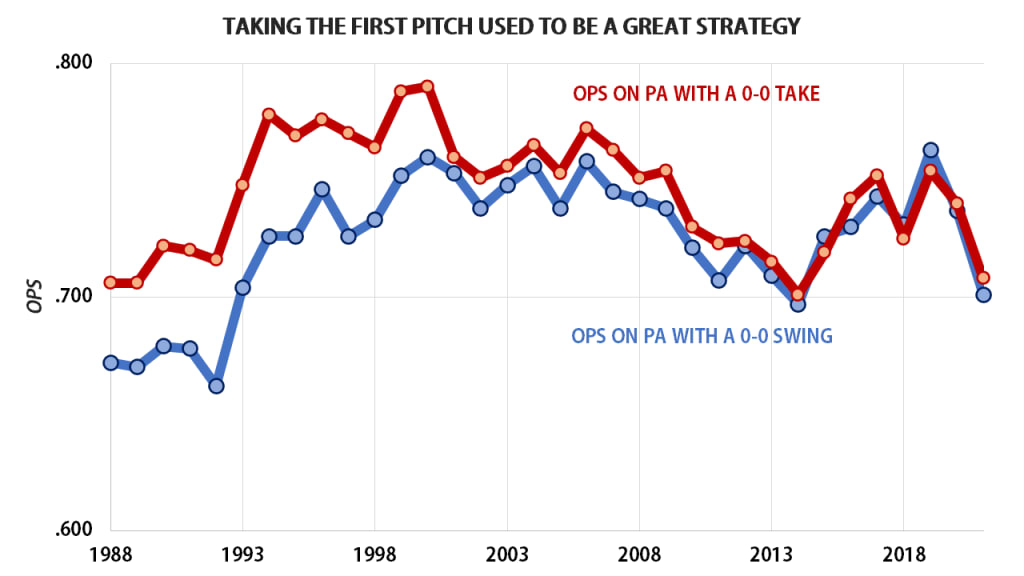
So far as Molina goes, he’s much more successful when attacking 0-0, posting a .984 OPS this year when he swings first pitch (.854 career) and a .684 OPS when he does not (.649 career). He's not the only one. None less than Mike Trout, baseball's greatest player, who was off to the best start of his career before he was injured, was being far more aggressive on the first pitch than he'd ever been before.
It's not that hacking on the first pitch is suddenly that One Magic Thing that will solve everyone's problems. It's that in an era where you're lucky if you get even a single hittable pitch from today's dominant pitchers, you'd best not let it go by. Years ago, the numbers said to take. The coaches said to take. The broadcasters said to take. It became clear a half-decade ago that was no longer necessary, or often advisable. As the first pitch swing/take decision no longer carries as much weight in the plate appearance outcome as it once did, the only strategy left is find that hittable pitch and hit it, regardless of what count it comes on.
Just don't get to two strikes, anyway. Nothing good can happen there.
